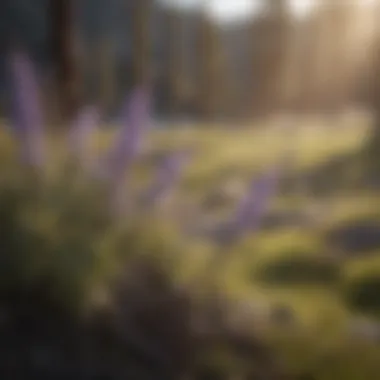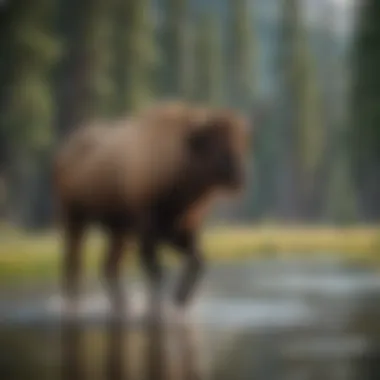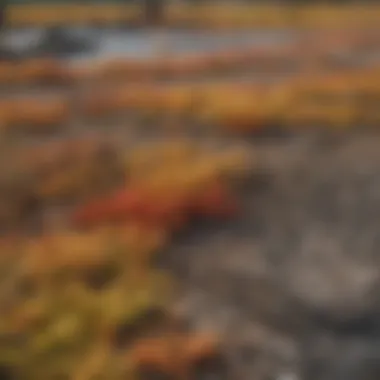The Seasonal Wonders of Yellowstone National Park


Prolusion
Yellowstone National Park is an ecological marvel that captivates visitors all year round. The seasons in Yellowstone are not just markers of time; they represent a spectrum of transformations that affect the landscape, wildlife, and overall visitor experience. Every traveler who enters the park has the chance to witness nature's vivid palette throughout the changing months, each bringing its own charm and awe-inspiring phenomena.
As the winter's icy grip begins to loosen, the park awakens in spring. This season is characterized by melting snow, blooming wildflowers, and the stirring of wildlife. Bears emerge from hibernation, elk calves take their first steps, and the air fills with birdsong. Summer, bursting with life and activity, invites adventure as people flock to experience varying recreational activities amid the lush greenery. The fall brings a tapestry of colors with the leaves turning, accompanied by migration patterns in wildlife, as animals prepare for the cold months ahead.
Understanding these seasonal dynamics is essential not just for practical planning but also for appreciating the deeper significance of this national treasure. From the thermal features unique to Yellowstone to its rich biodiversity, the seasons serve as a reminder of the constant ebb and flow of life in one of America’s most pristine environments. We will explore how each season uniquely enriches the visitor's experience and illustrates the intricate connections in nature's cycles.
Overview of Yellowstone National Park
Yellowstone National Park, often regarded as the crown jewel of the American wilderness, is a treasure trove of natural wonders. Spanning over 3,400 square miles, the park is not just a landscape; it’s a dynamic ecosystem teeming with life. Understanding the significance of Yellowstone requires delving into its rich historical context, geological intricacies, and vibrant biodiversity.
Historical Significance
The history of Yellowstone is as varied as its landscapes. Established as the first national park in the world in 1872, it has served as a beacon for conservation efforts globally. Before its designation as a park, the area was inhabited by Native American tribes for thousands of years. Their deep connection to the land is woven into the fabric of Yellowstone's identity.
Visitors today can trace remnants of these cultures through ancient sites, artifacts, and even oral traditions that recognize the park as a sacred space. This historical backdrop adds layers to the experience, transforming a simple visit into a journey through time.
Geological Features
One cannot speak of Yellowstone without bringing attention to its geological features. The park sits atop an active supervolcano, with geothermal phenomena such as geysers, hot springs, and mud pots defining its unique landscape. Old Faithful, perhaps the most renowned geyser, erupts at regular intervals, captivating onlookers with its intermittent displays of nature’s power.
Beneath the surface lies a complex network of volcanic activity that not only shapes the land but also fuels its ecosystem. The caldera formed by past eruptions reveals a delicate balance between destruction and creation—an ever-evolving landscape that challenges our understanding of geology. This aspect makes Yellowstone a living laboratory for scientists and a playground for curious visitors.
Biodiversity and Ecosystem
Yellowstone boasts an impressive array of biodiversity that supports countless species, from the tiniest insects to majestic grizzly bears. The park is home to over 1,700 species of plants, more than 300 species of birds, and a host of mammals including elk, bison, and wolves.
The interdependence of these species creates a complex ecosystem that thrives on biodiversity. For example, the presence of wolves in the park has been shown to regulate the populations of elk, which in turn affects vegetation growth and landscape health. Hence, every thread in this ecological tapestry plays a critical role in maintaining balance.
Moreover, each season unveils new life cycles and behaviors, providing insights into how species adapt to the changing environment. In Spring, for instance, newcomers such as bison calves take their first steps, while autumn brings migratory changes that can be witnessed across the park.
Understanding Yellowstone’s historical significance, geological features, and biodiversity is crucial for appreciating the deeper themes of environmental stewardship and preservation that resonate throughout the park. This rich backdrop is what draws countless visitors and researchers alike, ensuring that Yellowstone remains a cherished icon of natural beauty and ecological significance.
"Yellowstone is a shining example of the possibilities when humans work hand in hand with nature—not just to preserve, but to celebrate its magnificence."
Seasonal Breakdown
The seasons in Yellowstone National Park serve as a colorful canvas, painting each moment throughout the year with unique characteristics that draw in visitors, biologists, and nature enthusiasts alike. Understanding how these seasons shift is not just about appreciating beauty; it’s about grasping the deeper ecosystems at work and the dynamics of weather that affect flora and fauna. Each season holds its own flair, bringing specific elements — from migratory patterns of birds to the wildflower blooms that blanket the ground. For anyone looking to explore the park, knowing when to visit can make all the difference in capturing its true essence.
Spring in Yellowstone
Climate and Weather Patterns
Spring ignites life throughout Yellowstone, showcasing a gradual warming as snow melts and rivers swell with runoff. The climate can be a bit fickle; one moment the sun shines, and the next, a snow squall blankets the ground. This unpredictability is a hallmark of the season, affording visitors a chance to experience diverse weather in a single day. Average temperatures generally range from 30 to 60 degrees Fahrenheit. This variability provides a unique experience for visitors, as it reflects the resilience of nature — the hardy flowers push through despite the lingering cold. Yet, the flip side comes with challenges: weather can change at the drop of a hat, which means layering clothing is a wise choice to manage the temperatures.
Wildlife Activity
Spring is a busy time for wildlife in Yellowstone. Animals emerge from hibernation, and many mammals prepare for breeding. Bears are often spotted grazing on newly sprouted grass, while elk and bison move to lower elevations. This lively atmosphere makes spring a particularly rewarding time for wildlife watchers. The urgency of birth increases behavior activity as animals seek safe places for their young. With careful observation, one might catch a glimpse of playful cubs or calves, marking the start of new life. At the same time, visitors must be aware of their surroundings, as animal activity can increase encounters with the wild. It’s a definite trade-off: more wildlife sightings, but with the need for caution.


Visitor Experience
Visiting Yellowstone in spring offers a refreshing experience. The crowds are thinner than in the summer months, allowing for a more intimate interaction with nature. Trails that were closed due to snow are reopening, offering a fresh perspective on the park’s geological wonders. However, potential visitors should be prepared for variable conditions. Accessibility might be limited due to lingering snow, meaning plans shouldn’t be set in stone. But those who venture may find themselves rewarded with breathtaking views and the thrill of unexpected surprises as landscapes transform from winter to vibrant colors.
Summer in Yellowstone
Temperature Variations
Summer brings warmth and longer daylight hours to Yellowstone. Temperatures often climb into the mid-80s during the day, but nighttime can be much cooler, sometimes plummeting to the 40s. This range promotes a wealth of activities, whether you’re hiking up to see Old Faithful or enjoying a picnic by one of the serene lakes. For visitors, this temperature variability means it's crucial to be prepared for both heat and chill, especially if venturing to higher elevations.
Flora in Bloom
The bloom of flora in summer adds to the park’s splendor. Wildflowers explode in vibrant colors, carpeting the meadows with shades of purple, yellow, and red. This abundant growth is not just pleasing to the eye; it also supports pollinators including bees and butterflies, creating a buzzing ambiance. Rangers often describe the flower-laden valleys as golden carpets, creating a sensational vista that's perfect for photography. Summertime is the prime time for floraphiles, as one can see the array of plants unique to this ecosystem. Yet, with the abundance of visitors, some trails may be crowded. It’s a trade-off: magnificent visuals against the bustling crowds.
Peak Tourist Season
Summer acts as the peak tourist season, with millions flocking to the park. The influx leads to crowded attractions and busy roads, especially around well-known sites like Old Faithful and Grand Prismatic Spring. Accommodations often fill up quickly, so planning ahead is essential. Despite potential crowds, the vibrant life and warmth of summer offer unique experiences like ranger-led programs and evening wildlife spotting tours, enriching the experience for all who visit. Understanding when to arrive means navigating this bustling time, but for many, the beauty of summer makes it worth the commotion.
Autumn in Yellowstone
Foliage Changes
As summer fades, autumn steps in like an artist with a palette of gold, orange, and red. This season creates a stunning display in Yellowstone, where the trees transform dramatically, signaling the onset of colder weather. The foliage changes provide a backdrop that draws photographers and nature lovers. The vibrant colors serve not only as eye candy but mark a transition in the behavior of local wildlife. It’s not only aesthetically pleasing; it indicates changing ecosystems in preparation for winter. The brisk air also brings a crispness that’s invigorating. Although this season speaks volumes through its color, it also announces its impending change toward the more dormant winter months.
Wildlife Migration Patterns
Autumn signals a shift for many species in Yellowstone, particularly regarding migration. Animals like elk and bison start their journeys, moving to lower elevations for the winter months. The sight of a herd migrating is a powerful reminder of nature’s cycles. Visitors might hear the resounding calls of elk during mating season, creating an unforgettable auditory experience in the crisp air. However, it’s a critical time for these animals; disruptions can affect their migratory paths. For observing wildlife behavior, autumn is an ideal time, but caution is advised as animals can be more aggressive during breeding times.
Cooling Weather
As temperatures dip, cooling weather becomes a significant factor. Days can start warm but turn chilly by night, reminding visitors that winter is not far off. Dressing in layers becomes crucial, and potential visitors should be prepared for sudden temperature sways. This cooling is not without its perks; crisp fall days can be exhilarating and are often less crowded than summer. The shivers of a late autumn breeze might deter some, but for others, it’s the perfect backdrop to enjoy stunning views with a degree of solitude not found in peak season.
Winter in Yellowstone
Snowfall and Temperature Extremes
Winter transforms Yellowstone into a snow-covered wonderland where the landscape changes entirely under heavy snowfall. Average temperatures can plunge to the single digits, challenging both people and wildlife. Yet, for many, this harshness is part of the allure. The snow-laden trees and silent, glimmering landscapes offer an almost magical experience. However, winter driving in the park can be tough, as snowfall leads to road closures and limited accessibility. While some relish the adventure, this season does require preparation, and some must consider possible closures when planning a trip.
Hibernate and Survival Strategies
In winter, many creatures rely on unique survival strategies. Hibernation is crucial for some species, such as bears, while other animals adapt in fascinating ways. For instance, wolves are still active, hunting in packs to endure the snow-covered terrain. Understanding these survival methods gives insights into how life persists through harsh winters. Visitors might see animal tracks in the snow, clues that tell the story of life beneath the snow, which adds a layer of excitement for those willing to explore.
Winter Activities
Winter in Yellowstone isn’t just about solitude; it's also a hub for activities like snowshoeing, cross-country skiing, and guided snowmobile tours. These unique experiences attract a specific breed of outdoor enthusiasts eager to embrace the chill in a captivating environment. The park’s beauty during winter can be breathtaking, offering a stark contrast to the vibrant life observed in other seasons. However, navigating these activities often requires guidance, as the snow-covered landscape can be unpredictable. Planning ahead is necessary to enjoy the diverse offerings while ensuring safety.
Impact of Seasons on Wildlife Behavior
Understanding the intricacies of wildlife behavior in Yellowstone National Park throughout the seasons is essential for grasping how these animal populations thrive in such a dynamic environment. The four distinct seasons dramatically influence the life cycles of various species, including breeding patterns, foraging habits, and migration routes. The way animals adapt to seasonal changes reflects their resilience and the delicate balance of the park’s ecosystem.
Each season presents unique challenges and opportunities for wildlife, dictating not only their natural behaviors but also how they interact with their environment and one another. By observing these seasonal patterns, we gain deeper insights into the ecological interdependencies within Yellowstone, allowing us to appreciate the complexities of life in this remarkable habitat.


Breeding Seasons
In spring, the park awakens, and the rhythms of wildlife are dominated by breeding seasons. Species such as elk and bison engage in mating rituals, giving birth to their young during the relatively warm months. This timing ensures that newborns have a better chance of survival as food becomes increasingly available. The sounds of bulls bugling and females calling create a harmonious yet competitive atmosphere during these months.
Also noteworthy is how the varying elevations in Yellowstone influence breeding cycles. For instance, higher altitudes may see a delay in births due to lingering snow, while those at lower elevations flourish earlier. These synchronized behaviors are a vital part of maintaining healthy animal populations, enabling the success of future generations.
Foraging Patterns
As we transition into summer, foraging patterns shift significantly. Animals adapt to the explosion of foliage and the proliferation of insects. Bears, for example, shift from being opportunistic feeders to actively hunting and foraging for berries and other fruits. This is crucial, as they need to build up fat reserves for the coming winter. The increase in food availability allows various species, including deer and bison, to replenish their energy reserves after the strenuous breeding period.
Different animal species, including wolves, adapt their foraging strategies based on prey availability and competition. This seasonal abundance also attracts visitors interested in observing these behaviors, enriching the park's allure.
Hibernation and Migration
With autumn's arrival, the narrative continues to change as animals begin their migration or prepare for hibernation. Many bird species migrate south to escape the harsh winters, while mammals such as bears engage in preparatory behaviors, like accumulating body fat to sustain them during hibernation. The instinctive pull of these forces is deeply entrenched in their biological clocks, responding to decreasing light and temperature changes.
Interestingly, certain species, like snowy owls, display seasonal variability in their migration patterns based on food availability. This flexibility indicates an adaptation strategy to ensure survival even amidst fluctuating conditions.
As each season comes and goes, Yellowstone illustrates a compelling behavioral tapestry woven from the threads of adaptation and resilience. Through the examination of breeding seasons, foraging patterns, and strategies for hibernation and migration, we uncover the fundamental ways that wildlife responds to the cyclical nature of the environment—showing us that even in the wild, life has a rhythm all its own.
Visitor Experience throughout the Seasons
Experiencing Yellowstone National Park isn’t just about the sights; it's about how each season shapes the atmosphere, activities, and emotions felt by every visitor. Understanding the seasonal flux offers insights into why certain times of the year can significantly enhance or impact one's adventures within the park. Visitors who are aware of these seasonal differences can maximize their experience, ensuring memorable encounters in this iconic landscape.
Seasonal Attractions
Yellowstone boasts a variety of attractions, each season offering unique flair. Spring awakens the park from its frosty slumber, with wildlife ranging from newborn bison to playful bear cubs. The sight of these young creatures frolicking near lush flowering fields can steal anyone’s breath. Summer, the most popular time, draws crowds to its abundant hiking trails and deep blue geothermal features like the renowned Old Faithful. In autumn, the golden hues of aspens against the backdrop of the rugged mountains create a picturesque canvas, inviting photographers and nature enthusiasts alike. Lastly, winter transforms the park into a snowy wonderland, with mesmerizing ice formations along streams and the opportunity to partake in guided snowshoeing expeditions.
Sharing these seasonal highlights can entice potential visitors, making it crucial to understand what to look forward to in each phase of the year. This knowledge leads to more fulfilling, if not downright unforgettable, experiences.
Guided Tours and Accessibility
When planning a trip to Yellowstone, the means of exploration can vary widely with the seasons. Guided tours are a well-established method for a deeper understanding of the park’s unique ecosystem. In the warmer months, several companies offer bus tours that delve into the park’s rich history and ecology, often including stops at key attractions. These services allow visitors to focus on the enthralling narrative without worrying about navigation. However, accessibility can shift dramatically in winter. Many roads close to vehicular traffic, necessitating snowmobiles or snow coaches for access. Engaging a knowledgeable guide can significantly enhance the experience, providing insights into hidden gems often overlooked by casual visitors.
Accessibility Aspects
- Spring and Summer: Many facilities, including visitor centers and restrooms, are operational, with easy access to trails.
- Autumn: As temperatures drop, some services wind down, though the stunning views remain accessible.
- Winter: Limited accessibility requires planning; snow tours present a unique way to witness the serenity of a white-clad landscape.
Knowing these details can help in planning trips based on individual preferences or physical abilities, ensuring everyone can enjoy the park fully.
Safety Considerations
Another critical aspect of enjoying Yellowstone across its various seasons is understanding safety precautions. Each season presents distinct challenges. In spring and summer, the sheer number of visitors can increase wildlife encounters, making it vital to maintain a safe distance from animals. Following park regulations is essential; occasionally, bears and bison venture close to paths, and ensuring safety in such situations should be top priority.
Autumn might bring a false sense of security. While cooler temperatures are appreciated, shorter daylight hours can put a damper on late-day hikes. Visitors should always check weather conditions and plan ahead to avoid getting caught out in the dark.
Winter poses challenges as well: icy trails can be treacherous. Engaging in winter activities requires special gear and precautions to avoid getting lost in the vast white expanse.
Always remember, a prepared visitor is a safe visitor.


With safety tips ingrained in their minds, visitors can focus more on enjoying the stunning landscapes, unique wildlife, and spectacular ecological phenomena that make Yellowstone a cherished destination at any time of year.
Climate Change Influence on Seasons
In the grand tapestry of Yellowstone National Park, the influence of climate change weaves a thread that binds the various seasons together. Observing how shifts in climate affect this national treasure is crucial not only for ecological understanding but also for ensuring the park’s future vitality. The ongoing changes in temperature, expressions of altered weather patterns, and subsequent impacts on wildlife migration and breeding cycles create a complex dance that reveals much about our environment.
Temperature Shifts
The phenomenon of rising temperatures is an undeniable reality in Yellowstone, impacting everything from geyser activity to the comfort of visitors. Over recent decades, average temperatures have crept higher, significantly shifting the typical seasonal timeline. For instance, the spring thaw now occurs earlier in the year compared to historical averages. This advancement influences not just the melting of snow but also the blooming of vegetation. Early flowers can clash with traditional wildlife behavioral patterns, particularly for those species that depend on these plants for sustenance.
The effects can cascade throughout the ecosystem.
- Many species may face struggles in securing food if they find plants blooming too early or too late in the season.
- Animals like bears and elk depend on a delicate balance of seasonal transformations, where temperature shifts could impact birth rates or young survival rates.
These temperature variations, therefore, are not just numbers on a graph; they represent a shifting mosaic of life that requires adaptation from both flora and fauna.
Altered Weather Patterns
A consequence of climate change that starkly reflects in Yellowstone is the alteration of weather patterns. Where once the winters were predictably snowy, they are becoming less consistent with drier spells interspersed. Precipitation can fluctuate dramatically, leading to either unanticipated dry spells or intense flooding events. These shifts can create problems for both visitors and ecosystems, turning hiking trails into muddy paths or complicating animal foraging behaviors.
"Changes in weather patterns in Yellowstone can challenge established norms, creating urgency for adaptation and resilience in both human and animal populations."
For instance, during the summer months, increased occurrences of wildfires have been observed, fueled by drier conditions. Such fires not only threaten the park's natural beauty but also disrupt the delicate balance required for wildlife habitats.
Effects on Wildlife Migration and Breeding
When the seasons of Yellowstone begin to unravel due to climate change, the effects echo far beyond altered landscapes; they reverberate through the wildlife itself. Migration patterns that once followed a predictable rhythm are now in flux. Animals like the pronghorn antelope, known for their extensive migrations, are beginning to struggle with timing their journeys in sync with their food sources. Changes in plant life cycles can lead to mismatches in available forage at critical times, impacting animal health and population numbers.
Breeding seasons are also shifting, with potential implications for genetic diversity and overall herd vitality.
- Early springs may see young born to mothers who miscalculated the timing based on previous years’ patterns.
- Increased stress can lead to lower survival rates among the young, already a challenge in harsh conditions.
The consequences are profound: as the seasons shift, the very fabric of the ecosystem unravels, causing a ripple effect that can alter not just wildlife populations but the entire biodiversity of the park. As we continue to navigate our relationship with nature, these insights on the climate change influence become crucial for understanding what lies ahead for Yellowstone National Park.
Finale and Reflections
The seasons of Yellowstone National Park are more than just a change in weather; they mark critical shifts in the park’s character and ecosystems. As visitors traverse its trails and navigate through its valleys, understanding these seasonal changes can greatly enrich their experience. Every season paints the landscape in a different hue, shaping not just the scenery but also the flora and fauna that inhabit this iconic area. Being aware of these transformations allows visitors to plan their trips thoughtfully, maximizing their chances to witness the park's marvels at their peak.
Importance of Seasonal Awareness
Awareness of seasonal nuances is fundamentally important for several reasons. First and foremost, it ensures visitor safety. Each season has its own risks, from slippery winter trails covered in ice to the increased wildlife activity during the spring. Knowing what to expect can prepare adventurers to dress appropriately and heed any park advisories.
Beyond safety, there lies the benefit of engagement. The park acts as a stage where nature turns on its best performance as the seasons roll by. For instance, spring is alive with the sounds of nesting birds, while autumn showcases a dramatic palette of colors as leaves shift from green to gold and crimson. This isn't just about aesthetics; understanding the life cycles of plants and animals can deepen the appreciation for the biological intricacies at play.
In essence, seasonal awareness offers visitors a roadmap to fully experience the rich tapestry of life that Yellowstone embodies. By valuing these unique characteristics, visitors cultivate a connection to the land that can leave lasting impressions long after they have left.
Future of Yellowstone National Park
Looking ahead, the future of Yellowstone National Park is a topic of great importance as the interplay of climate change and seasonal patterns continues to evolve. Scientists are closely monitoring changing temperatures and weather events that could redefine this natural paradise. As conditions shift, so too may the park’s biodiversity. Some species might flourish, while others could struggle, not to mention the potential impact on migratory routes that are critical to various wildlife populations.
The park management is faced with the challenge of balancing visitor access while ensuring the preservation of ecosystems under threat. Programs aimed at educating the public about the importance of conservation will play a role here. Enhanced visitor experiences through innovative programs may foster greater environment stewardship among park-goers.
Moreover, the
“wild landscapes of Yellowstone provide a unique laboratory for ecological study that can shed light on how parks worldwide may adapt to global changes.”
It’s imperative that all those who cherish Yellowstone become advocates for its future. With ongoing efforts, from local community initiatives to national policy discussions, Yellowstone can remain a sanctuary for natural wonders, ensuring that generations to come can enjoy its seasonal dramas in all their glory.







